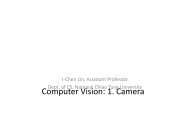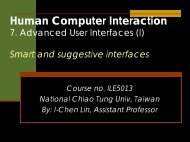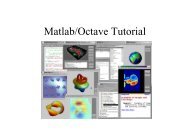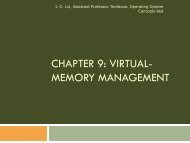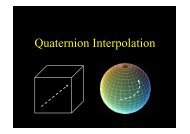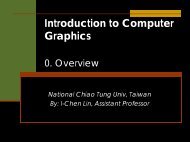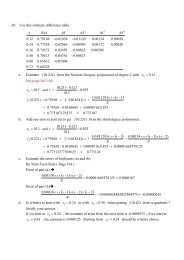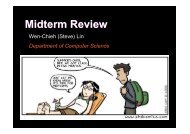Computer Graphics
Computer Graphics
Computer Graphics
You also want an ePaper? Increase the reach of your titles
YUMPU automatically turns print PDFs into web optimized ePapers that Google loves.
Example◦ Where did this image come from?◦ What hardware/software did we need toproduce it?
Preliminary Answer◦ Application: The object is an artist’s renditionof the sun for an animation to be shown in adomed environment (planetarium)◦ Software: Maya for modeling and renderingbut Maya is built on top of OpenGL◦ Hardware: PC with graphics card for modelingand rendering
Basic <strong>Graphics</strong> SystemOutput deviceInput devicesImage formed in FB
<strong>Computer</strong> <strong>Graphics</strong>: 1950-1960◦ <strong>Computer</strong> graphics goes back to the earliestdays of computing• Strip charts• Pen plotters• Simple displays using A/D converters to go fromcomputer to calligraphic CRT◦ Cost of refresh for CRT too high• <strong>Computer</strong>s slow, expensive, unreliable
<strong>Computer</strong> <strong>Graphics</strong>: 1960-1970◦ Wireframe graphics• Draw only lines◦ Sketchpad◦ Display Processors◦ Storage tubewireframe representation of sun object
Sketchpad◦ Ivan Sutherland’s PhD thesis at MIT• Recognized the potential of man-machine interaction.• Sutherland also created many of the now commonalgorithms for computer graphicsIvan Sutherland,Turing Award winner, 1988The console of the TX-2,Sketchpad Project
<strong>Computer</strong> <strong>Graphics</strong>: 1970-1980◦ Raster <strong>Graphics</strong>• Image produced as an array (the raster) of pictureelements (pixels) in the frame buffer• Allows us to go from lines and wire frame images tofilled polygons
<strong>Computer</strong> <strong>Graphics</strong>: 1980-1990◦ Realism comes to computer graphicssmooth shadingenvironmentmappingbump mapping
<strong>Computer</strong> <strong>Graphics</strong>: 1980-1990◦ Special purpose hardware• Silicon <strong>Graphics</strong> geometry engine◦ VLSI implementation of graphics pipeline◦ Industry-based standards• PHIGS◦ Programmer's Hierarchical Interactive <strong>Graphics</strong> System• RenderMan◦ Networked graphics: X Window System◦ Human-<strong>Computer</strong> Interface (HCI)
<strong>Computer</strong> <strong>Graphics</strong>: 1990-2000◦ OpenGL API◦ Completely computer-generatedfeature-length movies (Toy Story)are successful.◦ New hardware capabilities• Texture mapping• Blending• Stencil buffers, …
<strong>Computer</strong> <strong>Graphics</strong>: 2000-◦ Photorealism◦ <strong>Graphics</strong> cards for PCs dominate market• Nvidia, ATI, 3DLabs• GPU (<strong>Graphics</strong> processing unit)◦ Game boxes and game players determinedirection of market◦ <strong>Computer</strong> graphics routine in movie industry:Maya, Lightwave◦ Programmable pipelines
Light & Image◦ Objects◦ Viewer◦ Light source(s)◦ Attributes that govern how light interacts with thematerials in the scene◦ Note the independence of the objects, the viewer,and the light source(s)
Light◦ Light is the part of the electromagnetic spectrum thatcauses a reaction in our visual systems◦ Generally these are wavelengths in the range of about350-750 nm (nanometers)
Three-Color Theory◦ Human visual system has two types ofsensors• Rods: monochromatic, night vision• Cones◦ Color sensitive◦ Three types of cones◦ Only three values (the tristimulusvalues) are sent to the brain◦ Need only match these three values• Need only three primary colors
Additive and Subtractive Color◦ Additive color• Form a color by adding amounts ofthree primaries◦ CRTs, projection systems, positivefilm• Primaries: Red (R), Green (G), Blue (B)• Subtractive color• Form a color by filtering white lightwith:◦ Cyan (C), Magenta (M), and Yellow(Y) filters◦ Printing, Negative film
RGB & CMYK color model⎡ C⎢⎢M⎢⎣Y⎤⎥⎥⎥⎦=⎡1⎤⎢ ⎥⎢1⎥⎢⎣1⎥⎦−⎡R⎤⎢ ⎥⎢G⎥⎢⎣B⎥⎦K = min (C, M, Y)C = C – KM = M – KY = Y - KCyan = min (1, max(0, C - U(K))Magenta = min (1, max(0, M - U(K))Yellow = min (1, max(0,Y - U(K))Black = min (1, max(0, BK(K))
Basic 3D <strong>Graphics</strong>
What’s 3D?◦ How about thesepictures?
What’s 3D?◦ Is this correct?
Vanish point
Perspective projection◦ Taking photographing as an example.
Synthetic Camera Modelprojectorpimage planeprojection of pcenter of projection
Perspective projection (cont.)◦ Projection
Perspective projection (cont.)◦ Let pupils as the pinhole and a screen asthe film.
Generating perspective views◦ From the continuous world to a digital one.◦ Representing by surfaces?
Represented by primitives◦ Curves and surfaces are inefficient torender directly.
Represented by primitives (cont.)◦ We use primitives such as polygons instead.
Represented by primitives◦ Polygons
Represented by primitivesDigital Michelangelo Project, Stanford University
Represented by primitives (cont.)◦ A triangle is usually the most basicprimitive.◦ Polygons -> triangles.
Projection of trianglesADA’D’CBfocusC’B’Projection plane
Visibility◦ If we draw triangles directly, ourscreen will be a “mess”.◦ Remove hidden surfaces.
A realistic 3D view◦ Delicate 3D models.◦ Perspective.◦ Hidden surface removal.◦ Shading (lighting & reflection).◦ Shadow.◦ Detailed textures and normalsPixar corp.B. Martin, U. Utah
How to synthesize a view?◦ How to represent a object?◦ How to make the scene “move”?◦ How to display a 3D scene on screen?◦ How to efficiently simulate lighting effects?



